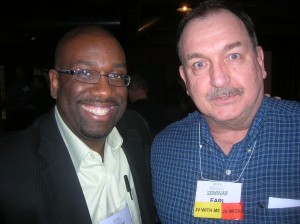Last weekend I attended Jeff Mills Boost Seminar in St Paul, Mn. which is so close to my home in South Minneapolis, I almost felt obligated to go.
The event was three days and on each of the days there were four presenters who shared with the gathered crowd about 90 minutes each. I found several of the presenters more personally useful than others, you may have found others more significant than I, depending on your particular interests and level of experience online.
My intention of to share some of the takeaways I got from the event over the next week or so, intermixed with my ongoing series on Product Creation. Otherwise I risk losing too much of the material.
As it is I will just be hitting some of the key points I learned, it would be too much work to redo all my notes and probably not fair to those who paid to attend the event and the speakers.
On the first day, the presenter who most impressed me with his willingness to share useful information was Greg Cesar.

His presentation was called, “How to Identify H0t Profitable Markets and Use PPC Advertising Like a Pro.”
Now I dip into and out of Pay Per Click from time to time, but it is not my main focus.
In today’s post I just want to focus on one key point that Greg hit home, that applies in many ways to many markets, media and circumstances, and that is what he called “Mind Set Questions.”
He is of course talking about prospects who might be clicking on a Pay Per Click ad, be it Google or some other. The question is where is that person, about to do the search in terms of their mindset. Are they just beginning a search for information, or are they about to make a buying decision.
I discuss this concept in another way on my blog on Top Public Speaking Tips as well. Whenever, you are selling or promoting an idea you need to not only know your product, but your audience.
You want to know who they are, what they are looking for, where they are going to get it, why they want it and when do they need it.
This of course is easier to say than to do. But in terms of Pay Per Click advertising a person searching for the keyword, “Digital Camera’s” is far more likely to be in the early information gathering stage than the person who is searching for: “Nikon Colorpix 4600”
Thus it makes sense to be creating keywords that are aimed at the prospect who is about to make that buying decision, doesn’t it?
—
Well let’s add one more for today: some keywords can get pretty expensive for pay per click advertising. But if you are willing to be creative you can come up with alternative words by thinking out of the box.
Here’s two ideas to get you started.
Rather than searching for keywords to substitute for Golf or Golfing, consider setting up local searches for the names of local golf courses to find your local niche interested in golf. Many will have few if any competitors and you should be able to find lots of local traffic that will be open to your golf related offer.
Another idea, I have implemented was to search on Amazon for book titles that were relevant to a particular topic. By looking for the top two or three book titles I choose one in one of my niches that was being searched for by word of mouth, and found that the only other advertiser for the title was amazon itself. My alternative product is now being seen and getting clicked on for much less than many of the long tail keywords I had previously been using.
[tags]pay per click, Greg Cesar, Keyword, keywords, Jeff Mills, Boost Seminar, long tail keywords [/tags]

